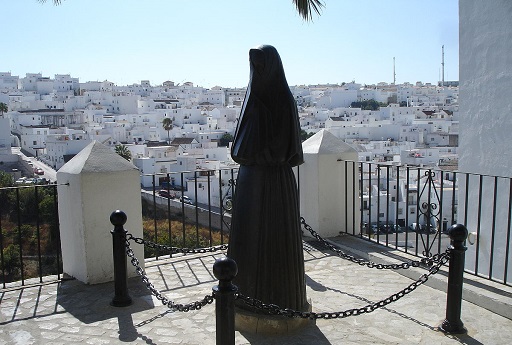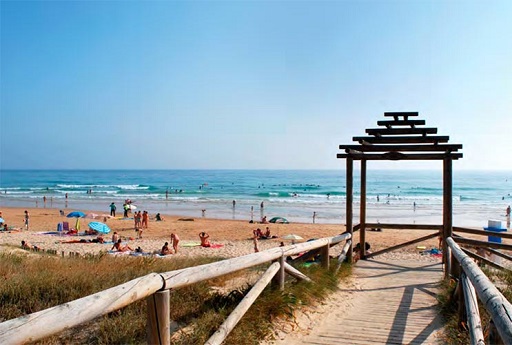WEIGHS MONUMENTAL
Imagine for a moment in a white hilltop town, one of those that you take out of a story, which for some is one of the most beautiful in Spain. That idyllic location of labyrinthine alleys and Nasrid patios that the Arabs impregnated in their path. The main attractions to see in Vejer de la Frontera go beyond those routes of patios and clay pots full of flowers, of its walls, its castle or a historic center that, if you travel outside rush hour, will leave you captivated. Vejer also has a beach, aqueducts… and even Windmills.

Spain Square
The entry into Vejer de la Frontera cannot be more triumphant than leaving the Casa Del Mayorazago aside., an 18th century Baroque-style manor house with two courtyards that is one of the most iconic monuments. Square, dating from the 15th century, it is the center that gives life to the town, a place with a lot of atmosphere. The ornamental fountain made from Sevillian tiles, located in the middle of the Plaza de España and also called “Fish Square”, was designed and created in the year 1955. It is flanked by 4 frogs that feed the goldfish and little Olivia's curiosity, where we also find the town hall.
Direction: Spain Square, Weighs

La Cobijada and its viewpoint
Monument to the woman who covered part of her face with a black cloak and only left one right eye visible. La Cobijada also refers to that typical and traditional Vejer de la Frontera costume that is used in patron saint festivals and has become a symbol. Its origin comes from the peninsular kingdoms in the seventeenth and eighteenth centuries, that is to say, Castilian. In fact, under the monument these verses can be read “sheltered that you discovered your captive face for the sake of freedom”, as a thank you and support for the liberation of women. This point is also one of the best viewpoints to see the most modern Vejer that maintains, of course, identity and white color.
Direction: Juan Bueno street

The Jewish Quarter and the Arch of the Nuns
Through the Puerta Cerrada Arch you can access the Jewish quarter, full of local craft shops and art galleries and a particularly photogenic street that ends at the Arco de las Monjas.
This arch is located right next to the Convent of the Conceptionist Nuns.
Direction: Jewish street

Castle of Vejer de la Frontera
The Castle of Vejer dates back to the X-XI centuries and is located at the highest point of the town, for strategic defense reasons. Vejer, Nevertheless, It is not an original Muslim settlement but Phoenicians passed through it, Carthaginians, romans (where the city was called Besaro), Visigoths and the Muslims themselves until it was reconquered by Ferdinand the Catholic. The visiting hours of the castle are from 10 at 2pm and from 16 a 18h, from Monday to Saturday. On Sundays it closes for the public.
Direction: Castillo street, 9

Convent of the Concepcionistas
The origin of the Convent of the Concepcionistas was occupied in 1584 by the conceptionist nuns, thanks to the one who receives its current name and Franciscan nuns. The Convent keeps several crypts inside, which makes this convent much more mysterious and interesting. Inside is the Municipal Museum of Customs and Traditions of Vejer. over the years 1993 Y 1994 It was restored to the final result, which is what we can see today: the walls were raised, a new vault was designed and built. This convent has two groups of chapels, those of the Gospel and those of the Epistle; and three crypts: of the founders, of the Franciscans and of the Conceptionist nuns.
Entrance costs € 1.
Direction: Convent of Our Lady of the Conception

Church of El Divino Salvador
On the same ground where this imposing church stands, there used to be a mosque. The Church of El Divino Salvador is a symbol for the town of Vejer and is one of the most visited monuments in the city. His style is a mixture of two construction stages, a first part that was built during the 14th century, which would be the header and which responds to the Gothic style – Mudejar; and a second part, late 15th century, early 16th, which corresponds to a later enlargement, already gothic style – late.
Direction: Father Angel Square 1

Medieval Wall
Vejer de la Frontera preserves some 2 kilometers of its medieval wall and serves as a reminder of when it functioned as a strategic element for the defense of the town. Strolling along the walls, following its walls and its streets, becomes an essential in your visit to Vejer. There are also three towers that protected and defended this wall.: Torre del Mayorazgo, San Juan Tower and Corredera Tower; Y 4 Villa gates: Arch of the Vila, South Arch, Arch of the Closed Door and Arch of Sancho IV.
Direction: Medieval wall

San Francisco Market
It is the ideal area if we want to make some purchases. It is a food market, formerly food market, where to enjoy the Andalusian atmosphere and taste typical products and dishes of the area. A market is always a good place to stop to meet and enjoy the local people, the authenticity that is breathed in a typical market you will not find anywhere else.
Direction: San Francisco Street 3

The Sliding
The Sliding, gives access to one of the most beautiful and photogenic views of the city. Through it we can skirt the city to the Puerta de Sancho IV and the Iglesia Convento de la Merced de Santa Catalina, leaving as a backdrop the mountains that surround Vejer de la Frontera as well as charming terraces and restaurants..
Direction: Corredera street 21

Church of the Merced of Santa Catalina
Although it began to be built in 1633, church (and Convent) of Our Lady of Mercy of Santa Catalina did not begin to be used as a place of prayer until 1946. But before this, this church lived a lot of history, including an earthquake with terrible consequences for the structure of the same, in 1773, although the church is preserved in a fairly good state of renovation.
Direction:Father Caro Square 4

Windmills
To this day in Vejer they are preserved 7 flour mills: San Francisco, Saint Joseph, San antonio, Cross of Conil, Holy Ines, Marquez and Morillo. They were all built in the 19th century, except the mill of Santa Inés, dating from the 18th century and that of Márquez, early 20th century.
In the past, these mills were used to grind the wheat; Today they are part of the landscape and constitute an important part of the historical legacy of the town. These mills were built following the Cartagena model, a more solid construction with a lower tower height and thicker walls, which was better adapted to the strong winds that blew across the La Janda coast. Their area is approximately thirty square meters and they are made up of two different parts: a slightly frusto-conical base and the roof. The base is built with strong masonry walls up to 1,5 meters high. The roof is a conical wooden structure covered by a layer of zinc and is supported by a wooden structure called a loom that allowed it to rotate., thus being able to orient the eight blades towards the prevailing wind. Then the four sails were deployed depending on the strength of this.
These mills have two plants. The ground floor was used for the collection of flour and also housed a small kitchen area under some spiral staircases that led to the upper floor., where the grinding took place. The miller deposited the wheat in the hopper, a funnel-shaped structure that allowed it to fall on the grinding stones: the mobile hearth and the fixed flywheel.
Abandoned by the passage of time, some of these mills were restored by the Vejer City Council, in collaboration with the Junta de Andalucía and the Diputación de Cádiz.
BEACHES OF VEJER

El Palmar Beach
Although a bit far from the town, El Palmar beach belongs to Vejer de la Frontera and is an essential place if what you want is to contemplate one of the most beautiful sunsets in Cádiz, in addition to a large stretch of fine sand beach in an incredible environment, ideal for those who like water sports like surfing.
Visit El Palmar AQUI